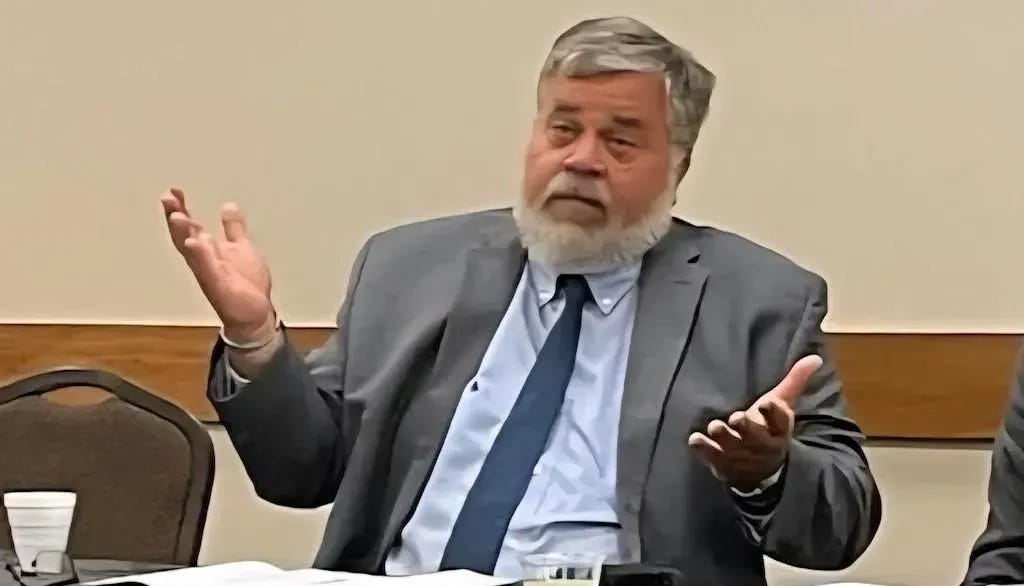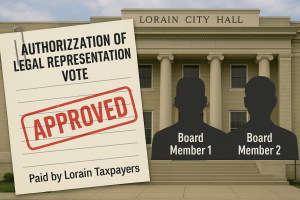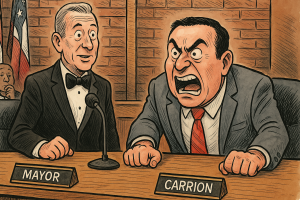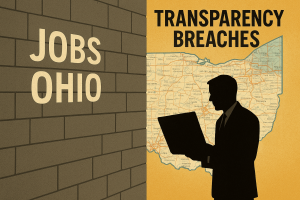The Counselor’s Contradiction: Dan Petticord and the Politics of Passive Power
Behind every scandal is a strategist—how Assistant Prosecutor Dan Petticord used silence, selective memory, and procedural control to shape the downfall of JD Tomlinson.
May 15, 2025
Byline:
Aaron Knapp is an investigative reporter and public accountability advocate based in Lorain, Ohio. He has written extensively on local government misconduct, retaliation in public institutions, and systemic failures in transparency. This article is part of his ongoing exposé series through Lorain Politics Unplugged.

Thanks for reading Aaron’s Substack! Subscribe for free to receive new posts and support my work.
I. The Man Behind the Curtain
When the Lorain County Prosecutor’s Office began to unravel in mid-2023, most of the public focus fell on the combustible relationship between JD Tomlinson and Jennifer Battistelli. Yet within the depositions, emails, and payout records lies a quieter architect—Assistant Prosecutor Dan Petticord. He didn’t scream, threaten, or break policy in public. He didn’t need to. Petticord’s influence was bureaucratic, surgical, and deeply consequential.
In his deposition, Petticord confirmed that he had known about the romantic relationship between Tomlinson and Battistelli since the summer of 2021. “She and JD had had kind of an on-again, off-again romantic relationship over a number of years,” he testified. This puts him at the earliest point of knowledge—before the personnel changes, before the promotion, and before the internal blowup. And yet, he did nothing.
Initially, Petticord expressed no objection to the relationship. Battistelli recalled that he said it was “okay.” Then, months later, he reversed course and told the couple they could not date. What changed? Petticord never explains. But the timeline suggests his shift coincided not with ethical reflection, but with legal and political exposure. In short: it only became a problem once someone might get caught.
But Petticord’s passive posture would take a more active turn when the HR complaints began. After Garrett Longacre accused Battistelli of making false allegations, Petticord, again, played both sides. He informed Longacre of the complaint against him but also expressed that he didn’t believe discrimination occurred. Then, rather than mediate or investigate thoroughly, he turned the matter over to Burge and Resendez, who swiftly launched a disciplinary response against Battistelli.
What Petticord didn’t do is just as revealing. He didn’t notify CORSA, the county’s insurance provider. He didn’t forward the EEOC complaint to the Board of Commissioners. He didn’t initiate any independent review of the claims—despite knowing they included allegations of racial bias and physical assault. Instead, he helped push through a $100,000 payout as a “requisition,” bypassing standard resolution procedures.
That payout, orchestrated in collaboration with James Burge, became the crown jewel of the cover-up. And Petticord’s fingerprints are everywhere. He received the EEOC complaint on October 10, showed it to Burge on October 11, and worked internally to keep it hidden. “We relied on Meta v. Ohio University,” Burge testified, referencing legal advice allegedly provided by Petticord to justify withholding the document as “false and defamatory.”
When questioned by Rosenbaum, Burge admitted he relied heavily on Petticord’s guidance. Petticord, in contrast, deflected. He maintained a veneer of detachment, rarely giving a clear yes or no. His deposition is filled with caveats: “I don’t recall,” “I’m not sure,” “I wasn’t involved in that aspect.” But at every crucial moment, it was Petticord who received the documents, signed off on the responses, and worked behind the scenes to manage the fallout.
His legal rationale for the concealment? That the EEOC complaint, if considered false, could be withheld under defamation protections. But as courts later ruled, the complaint was a public record. Petticord’s strategy had bought time, but it didn’t hold.
What becomes clear is that Petticord operated not as a neutral prosecutor, but as an internal fixer. He managed risk, not justice. He created distance between himself and the scandal’s ignition point while keeping his hand on the fuse.
II. The Meta Memo, the Missing Records, and the Machinery of Delay
If the cover-up of the EEOC complaint had a playbook, it began with what witnesses called “the Meta memo.” Burge and others testified that Petticord cited Meta v. Ohio University as legal justification to withhold the complaint on the basis that it was defamatory and therefore not a public record. But there’s a problem: no such memo was ever produced.
When pressed during depositions, no one—not Burge, not Petticord, not any attorney on the county payroll—could provide the memo or cite where the interpretation came from. Petticord allegedly gave the verbal green light to use the case, but never authored a formal analysis. It was legal strategy by ghost signal—an invisible doctrine passed by implication, never committed to paper.
This tactic allowed Petticord to maintain plausible deniability. If the strategy worked, he could claim credit as legal counsel. If it failed, he could say he never authored a memo and the decision rested with someone else. It’s the prosecutor’s version of Schrödinger’s memo—existing and not existing at the same time.
Meanwhile, the complaint itself was buried. Petticord did not send it to the Board of Commissioners. He did not notify CORSA. He allowed the payout process to unfold under a “requisition” rather than a formal resolution. In doing so, he ensured the claim could be settled without triggering the oversight mechanisms built into county policy.
To the public, the delay in release of the EEOC filing appeared bureaucratic. But to those inside the office, it was strategic. Every day that passed bought Tomlinson more distance from the incident. Every procedural bottleneck created plausible reasons to withhold. And all of it flowed through Petticord.
What was most telling was what didn’t exist: no formal referral for outside legal review, no paper trail of internal objections, and no attempt to resolve the contradiction between Burge’s reliance on Meta and the absence of any written legal opinion.
When the court later ruled the EEOC complaint was, in fact, a public record, it was too late. The payout had already cleared. The complaint had been suppressed long enough to protect Tomlinson’s office from immediate exposure. Petticord’s machinery of delay had done its job.
In a healthy legal office, missing documentation of this scale would prompt concern. In Lorain County, it was treated as routine. Petticord didn’t lose his job. He wasn’t investigated. He simply melted back into his role—untouched, unnamed, and unaccountable.
In this scandal, what wasn’t written down may be the most important record of all.

III. Selective Memory and the Art of the Non-Answer
One of the most telling aspects of Petticord’s deposition was not what he admitted—but what he artfully avoided. Over and over again, he answered questions not with facts, but with fog: “I don’t recall,” “I’m not sure,” “That’s not something I would’ve been directly involved in.” These phrases didn’t just protect him—they insulated the entire office.
Take, for example, the question of when he first learned about Battistelli’s EEOC complaint. Despite being the recipient of the actual complaint, Petticord hedged on the specifics. He acknowledged receiving it on October 10, 2023, but claimed he was unsure whether he fully read it before sharing it with Burge. It’s a peculiar kind of detachment: aware enough to be involved, disengaged enough to escape scrutiny.
This pattern of deflection repeated throughout his testimony. When asked if he offered legal guidance on withholding the EEOC complaint, he stated he “did not recall” offering any formal advice. Yet Burge and others testified that Petticord specifically cited the Meta v. Ohio University case as grounds to withhold. Which account is true? Petticord’s strategy was clear—leave just enough ambiguity to avoid accountability.
Such rhetorical evasions aren’t just frustrating—they’re effective. Petticord managed to keep his name out of most press coverage, despite his documented role in almost every step of the scandal. He avoided perjury by avoiding precision. He didn’t lie—he just left blanks where truth should have been.
In a legal context, this selective memory has a chilling effect. Depositions are meant to clarify. Petticord used his to cloud. This is the legal equivalent of graymail—blurring the lines so thoroughly that no one can pin blame without a confession.
And it worked. While others in the Prosecutor’s Office faced fallout, Petticord remained. His refusal to take definitive stances allowed him to blend into the procedural wallpaper—present, instrumental, but ultimately invisible to consequences.
What’s especially troubling is how this strategy undermines the entire investigative process. If public officials can dodge accountability simply by saying “I don’t remember,” then our systems of oversight become meaningless. Petticord didn’t just exploit the law—he gamed the system meant to uphold it.
This is not a case of forgetfulness. It’s a case of strategy. A well-rehearsed, legally informed strategy of non-answers, designed to stall, confuse, and deflect. It protected Petticord in the short term—but it also left behind a pattern that, when stitched together, reveals more than any one admission ever could.
In Petticord’s silence, the architecture of denial becomes visible. And what it shows is a man who didn’t just witness the collapse—he quietly directed the scaffolding as it fell.

IV. The Ethics Shield: How Legal Language Became a Political Tool
Dan Petticord didn’t just work within the law—he weaponized it. At every turn in the unraveling of the Prosecutor’s Office, Petticord leaned not on truth or transparency, but on his command of legal ambiguity. Ethics, to him, weren’t standards to be upheld. They were shields to be manipulated—moral language layered over political maneuvering.
This became especially clear in how Petticord addressed the EEOC complaint. Rather than recommend a public release or an impartial legal review, he invoked concerns about defamation and privacy. But not because he believed the complaint to be wholly false. Rather, because labeling it as such gave the office legal cover to bury it. The argument wasn’t whether it was credible—it was whether it could be withheld.
It was a cold calculus: by treating allegations of discrimination and assault as “potentially defamatory,” Petticord transformed a government record into an internal liability shielded from public scrutiny. He didn’t resolve the issue—he reclassified it.
And it worked, for a time. Burge, Resendez, and even the commissioners deferred to Petticord’s interpretation. His quiet demeanor and legal credentials masked the maneuver. To most, he appeared prudent. In truth, he was curating silence.
When confronted during deposition about why the complaint was never referred to CORSA or the commissioners, Petticord invoked confidentiality and process. “It wasn’t my role to make that referral,” he claimed. Yet he never stopped it from proceeding through an unconventional channel, either. He didn’t break the law—he sidestepped it.
This is Petticord’s power: never the face of a scandal, but always the architect of its containment. The ethical guidelines he invoked were not used to uphold public integrity. They were deployed as procedural armor—armor he knew few would challenge.
In the end, his legal opinions functioned not as clarifiers, but silencers. His language was sterile, cautious, and laden with qualifiers. It was the language of someone who knew how to close doors without making noise.
And that, ultimately, is what makes Petticord’s conduct so dangerous. He understood the ethics system well enough to bend it just before it broke. He didn’t have to lie—he just had to stall, obscure, and interpret. And for a county struggling with transparency, that was enough to collapse the truth beneath the weight of its own red tape.

V. Ghost Protocol: Petticord’s Role in the Payout Without a Paper Trail
The $100,000 settlement paid to Jennifer Battistelli did not go through a court order. It was not processed through CORSA, the county’s risk management pool. It wasn’t even routed through a formal resolution approved by the Lorain County Board of Commissioners. Instead, it was quietly funneled through a simple requisition—a mechanism that, while technically legal, avoids almost all forms of public scrutiny.
And the man guiding that invisible handoff? Dan Petticord.
Deposition testimony from James Burge confirms it. “Dan got the complaint on October 10,” Burge said. “I saw it on the 11th. We moved on it right away.” That “movement” wasn’t toward transparency. It was toward containment. The decision to bypass a resolution and instead push the payment through requisition gave the office plausible deniability and a fire escape from political fallout.
Requisitions are typically used for routine expenses—office supplies, contracts, services. They are not the standard vehicle for a six-figure discrimination and assault payout. But by using this route, Petticord and Burge ensured that the commissioners didn’t need to vote, the public wouldn’t know, and insurance providers wouldn’t intervene.
In fact, CORSA was never informed. The county’s own legal insurer was left out of the process, meaning taxpayers were left on the hook for the entire $100,000 payout. This is more than bad judgment—it’s administrative evasion.
What makes Petticord’s role even more suspicious is how carefully he avoided leaving fingerprints. He didn’t sign the memo. He didn’t send the denial letter. He didn’t present anything at a public meeting. But by legal custom and procedural practice, none of those things were required—so long as someone else did the paperwork.
That someone else was Burge. But every document Burge cited in his deposition points to discussions with Petticord. The Meta case? Suggested by Petticord. The decision not to release the EEOC complaint? Reviewed with Petticord. The decision to issue a requisition rather than a formal resolution? Again—discussed with Petticord.
This is the “ghost protocol” Petticord operated under: architecting the infrastructure of a legal response without ever touching the blueprint. No fingerprints, no accountability. But no one else in the office had the authority or legal grounding to pull it off. This was Petticord’s show—he just directed it from the shadows.
That’s not legal stewardship. That’s insulation by design.

VI. The Quietest Power Move: Rewriting the Record Without Touching the Pen
There are power plays in politics that make headlines—firing someone, leaking a memo, or issuing a public statement. Dan Petticord’s influence worked in the opposite direction. He didn’t shout. He whispered policies into existence, erased paper trails by never creating them, and controlled narratives by managing what never got documented. It was not just subtle—it was surgical.
Consider the decision not to share Battistelli’s EEOC complaint with the Lorain County Commissioners. Petticord didn’t sign a memo blocking its release. He didn’t argue at a public meeting. He simply didn’t send it. That single inaction rewrote what the public, the commissioners, and even CORSA knew. The decision to suppress wasn’t announced. It was implemented through absence.
In the world of public records and legal liability, what is not said is just as powerful as what is. Petticord understood this. By advising Burge and Resendez privately, instead of authoring official communications, he built legal buffers that protected himself while letting others carry out the strategy. He ghostwrote the logic, but never left an author tag.
This pattern continued when it came to legal justification. Petticord didn’t write a formal legal brief declaring the EEOC complaint false or defamatory. Instead, he suggested Meta v. Ohio University informally—an offhand legal cue that others ran with. When asked about it under oath, Petticord had nothing to retract because he had written nothing down.
And when the time came to authorize the $100,000 payout? Again, Petticord did not sign the requisition. But every step in the process referenced prior discussions with him. The absence of his name on documents wasn’t an oversight—it was insulation. It was a chess move played three turns ahead.
Even the public narrative was shaped by Petticord’s invisible edits. By never speaking to the media, never taking a position in public, and never inserting himself into the drama, he avoided scrutiny entirely. While Burge, Tomlinson, and Battistelli were grilled, Petticord was barely mentioned.
But the record tells a different story. Everyone inside the office points to him. They asked him for legal advice. They waited on his go-ahead. They shaped their strategy based on what he said could and couldn’t be done. That’s not passive presence—that’s shadow governance.
It’s no exaggeration to say that Petticord rewrote the history of the scandal by managing its documentation. The result was a timeline full of blanks—blank memos, blank answers, blank referrals—that gave him maximum proximity to power with minimum exposure.
In the end, it wasn’t what Dan Petticord wrote that shaped the course of events—it was what he didn’t write. His fingerprints are missing from the files because he never touched the paper. But make no mistake: the pen was in his hand the whole time.
VII. Conclusion: Passive Power, Lasting Consequences
Dan Petticord never raised his voice. He never appeared on the news. He didn’t send any emails that made headlines. Yet his actions—or more often, his inactions—shaped the trajectory of the most consequential personnel scandal to strike the Lorain County Prosecutor’s Office in recent memory.
He was the first to know about the relationship. He advised the team that buried the EEOC complaint. He helped draft the legal logic used to justify its suppression. He let a $100,000 payout slide through without the usual oversight. And at every juncture, he did just enough to steer the outcome—without ever leaving his fingerprints behind.
This is not just about one man. It’s about the structure of legal power and how it can be used to smother accountability. Petticord understood the limits of transparency laws and ethical obligations better than anyone around him. But instead of using that knowledge to serve the public, he used it to obscure the truth. He managed fallout, not fairness.
His strategy of silence and procedural opacity worked. It bought time. It shielded colleagues. It protected the office’s reputation—until it couldn’t. By the time the complaint surfaced and the court forced its release, the damage had already been internalized. The public had been denied their right to know. The commissioners had been kept in the dark. And the prosecutor’s inner circle had survived just long enough to write their own version of events.
Petticord wasn’t the fall guy. He wasn’t the hero. He was something far more dangerous: the person who knows where all the ethical boundaries are—and quietly walks the edge without ever crossing the line in view.
That is passive power. That is why systems break without a bang. And that is how public trust erodes—not in scandal, but in silence.
Disclaimer:
This article is based on verified depositions, public records, sworn testimony, and first-hand documents obtained by the author. All quotes and timelines reflect the available legal evidence as of publication. Allegations described herein are drawn from official proceedings and investigative sources. Any opinions expressed are the author’s own, rooted in documented fact and professional analysis.





